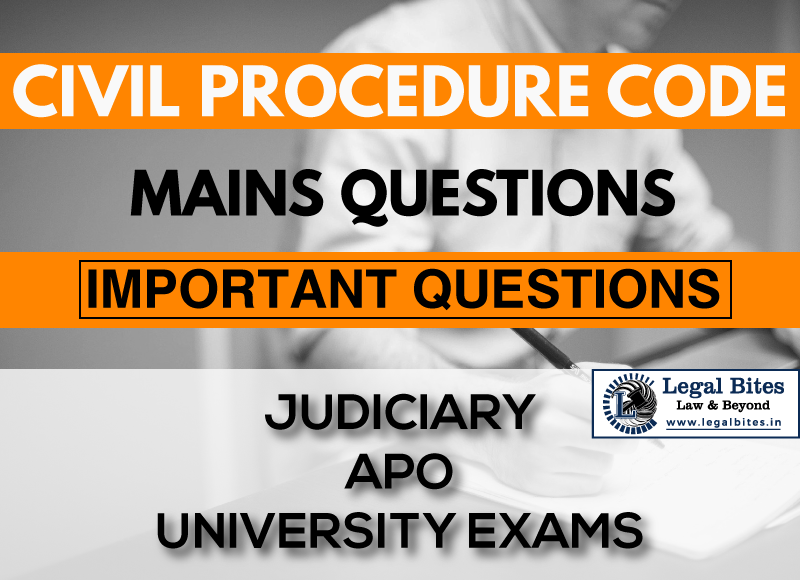Discuss legal provisions ..... withdrawal of suit. Whether Transposition of defendants as plaintiffs may be permitted?....
Find the answer to the mains question only on Legal Bites.

Question: Discuss legal provisions relating to withdrawal of suit. Whether Transposition of defendants as plaintiffs may be permitted? If so, when? [MPJS 2021]Find the answer to the mains question only on Legal Bites. [Discuss legal provisions relating to withdrawal of suit. Whether Transposition of defendants as plaintiffs may be permitted? If so, when?]AnswerUnder Order XXIII of the Code of Civil Procedure (CPC), 1908, provisions regarding the withdrawal of suits are outlined. The...
Question: Discuss legal provisions relating to withdrawal of suit. Whether Transposition of defendants as plaintiffs may be permitted? If so, when? [MPJS 2021]
Find the answer to the mains question only on Legal Bites. [Discuss legal provisions relating to withdrawal of suit. Whether Transposition of defendants as plaintiffs may be permitted? If so, when?]
Answer
Under Order XXIII of the Code of Civil Procedure (CPC), 1908, provisions regarding the withdrawal of suits are outlined. The plaintiff has the right to withdraw a suit at any stage of the proceedings; however, this right is subject to certain conditions:
Withdrawal Without Permission (Order XXIII, Rule 1(1)): A plaintiff may withdraw a suit or abandon a part of the claim unconditionally. In such cases, the plaintiff may not file a fresh suit on the same cause of action unless granted permission by the court.
Withdrawal With Permission (Order XXIII, Rule 1(3)): If the plaintiff withdraws the suit with the intention to institute a fresh suit on the same subject matter, they must seek permission from the court. Such permission is granted when the court finds that the suit suffers from a formal defect or there are other sufficient grounds for the withdrawal. Once granted, the plaintiff may file a new suit on the same cause of action.
Effect of Withdrawal: Once the suit is withdrawn unconditionally without permission to file a fresh suit, the plaintiff cannot bring another suit on the same cause of action.
Transposition of Defendants as Plaintiffs
Transposition refers to changing the position of a defendant to that of a plaintiff during the course of litigation. This is governed by Order I, Rule 10(2) of the CPC. Transposition of defendants as plaintiffs may be permitted under specific circumstances:
When Allowed:
Courts may permit transposition of a defendant to the position of a plaintiff if it is deemed necessary for the proper adjudication of the case. Typically, this happens when:
(i) The plaintiff has withdrawn from the suit or failed to prosecute it, but some defendants have an interest in continuing the case to safeguard their rights.
(ii) The defendant has a cause of action aligned with the plaintiff's claim or where the outcome would affect the defendant's legal rights.
Conditions for Transposition:
The court must be satisfied that the transposition would help in effectively determining the real issues in the case. The permission for transposition is granted in situations where refusing it may lead to injustice or when the plaintiff has abandoned the claim but the defendant has a substantial interest in continuing the litigation.
The legal framework for the withdrawal of suits provides plaintiffs with both flexibility and safeguards, while transposition allows for the adjustment of parties to ensure that justice is served by permitting defendants to step into the plaintiff's shoes when necessary.
Important Mains Questions Series for Judiciary, APO & University Exams
- CPC Mains Questions Series: Important Questions Part – I of X
- CPC Mains Questions Series: Important Questions Part – II of X
- CPC Mains Questions Series: Important Questions Part – III of X
- CPC Mains Questions Series: Important Questions Part – IV of X
- CPC Mains Questions Series: Important Questions Part – V of X
- CPC Mains Questions Series: Important Questions Part – VI of X
- CPC Mains Questions Series: Important Questions Part – VII of X
- CPC Mains Questions Series: Important Questions Part – VIII of X
- CPC Mains Questions Series: Important Questions Part – IX of X
- CPC Mains Questions Series: Important Questions Part – X of X

Mayank Shekhar
Mayank is an alumnus of the prestigious Faculty of Law, Delhi University. Under his leadership, Legal Bites has been researching and developing resources through blogging, educational resources, competitions, and seminars.
